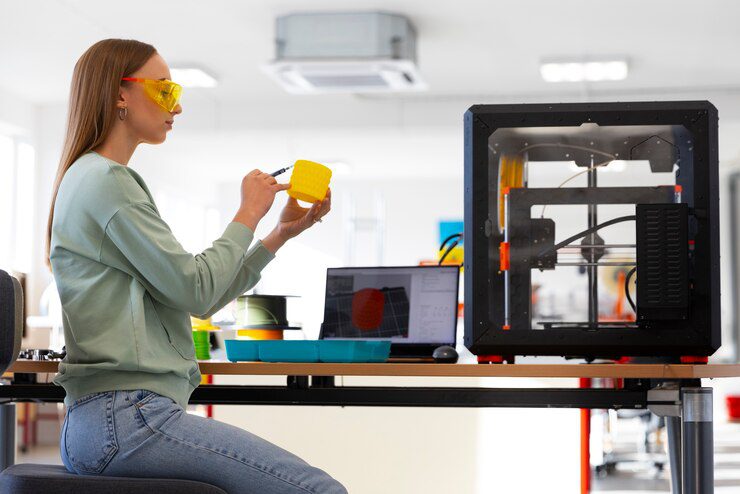In the rapidly evolving world of manufacturing, 3D printing stands out as a game-changer. What was once considered a niche technology is now revolutionizing the industry, offering innovative solutions that redefine production processes. From prototyping to mass production, 3D printing is transforming how we create and consume products. Here’s a look at how this technology is reshaping the manufacturing landscape.
The Rise of 3D Printing in Manufacturing
3D printing, or additive manufacturing, involves creating objects layer by layer from a digital model. Unlike traditional subtractive manufacturing, which cuts away material from a solid block, 3D printing builds up objects, allowing for complex designs and customized production.
Key Statistics:
Market Growth: The global 3D printing market is expected to reach $55.9 billion by 2027, growing at a CAGR of 23.3% from 2022.
Cost Efficiency: Companies using 3D printing for prototyping have reported cost reductions of up to 70% compared to traditional methods.
Revolutionizing Prototyping and Design
One of the most significant impacts of 3D printing is in the realm of prototyping and design. Traditional methods often involve lengthy and expensive processes to create prototypes. With 3D printing, designers can quickly produce and iterate on prototypes, speeding up the development cycle and reducing costs.
| Advantages of 3D Printing in Prototyping | Traditional Methods |
| Rapid production of prototypes | Timeconsuming and expensive |
| Lowcost materials and processes | High material waste and costs |
| Ability to iterate quickly on designs | Limited flexibility for design changes |
Enhancing Customization and Personalization
3D printing excels in customization, allowing manufacturers to produce bespoke items tailored to individual needs. This capability is transforming various industries, from healthcare to fashion, by enabling the creation of personalized products at scale.
Examples of Customization:
Healthcare: Custom prosthetics and dental implants can be precisely tailored to fit individual patients.
Fashion: Designers are experimenting with 3D-printed clothing and accessories, offering unique, made-to-order pieces.
Streamlining Supply Chains
Another way 3D printing is changing the game is by streamlining supply chains. Traditional manufacturing often involves complex supply chains with multiple stages and suppliers. 3D printing simplifies this by allowing for on-demand production, reducing the need for extensive warehousing and inventory.
Benefits for Supply Chains
Reduced Inventory Costs: On-demand production means less need for storing large quantities of parts.
Faster Turnaround: Products can be made as needed, reducing lead times and improving responsiveness.
Innovations in Material Science
3D printing is also driving advancements in material science. New materials, such as advanced polymers and metal alloys, are being developed specifically for 3D printing applications. These materials offer enhanced properties, such as greater strength and flexibility, expanding the potential uses of 3D printing.
| Innovative 3D Printing Materials | Applications |
| Carbon fiber composites | Aerospace and automotive parts |
| Biodegradable plastics | Eco-Friendly packaging and products |
| High-Performance metals | Industrial components and tools |
RealWorld Applications and Success Stories
Many companies are harnessing the power of 3D printing to drive innovation and efficiency. Here are a few notable examples:
Boeing: Utilizing 3D printing to produce lightweight aircraft components, reducing weight and fuel consumption.
Adidas: Creating custom, 3D-printed midsoles for their sneakers, offering a perfect fit and enhanced performance.
NASA: Developing 3D printed parts for spacecraft, enabling quicker and more cost-effective production of critical components.
Challenges and Future Outlook
Despite its transformative potential, 3D printing faces challenges. Issues such as material limitations, speed, and scalability need to be addressed to fully realize its benefits. However, ongoing research and technological advancements are continually overcoming these hurdles.
Looking Ahead:
Increased Adoption: As technology advances, expect broader adoption across industries, including automotive, aerospace, and consumer goods.
Technological Innovations: New developments in materials and printing techniques will expand the capabilities and applications of 3D printing.
Conclusion
3D printing is undeniably transforming the manufacturing landscape, offering unparalleled opportunities for innovation, customization, and efficiency. As the technology continues to evolve, it promises to unlock even more potential, reshaping how products are designed, produced, and consumed. Embracing 3D printing is not just about keeping up with trends but about leading the way in the future of manufacturing.
In a world where speed, customization, and efficiency are king, 3D printing is setting the pace for the next wave of manufacturing innovation. Whether you’re a manufacturer or a consumer, understanding and leveraging the power of 3D printing can open doors to endless possibilities.







